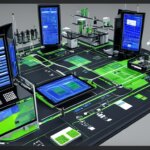Table of Contents
In today’s digital age, where cyber threats loom large, organizations must be proactive in safeguarding their sensitive data. Air gaps, a fundamental cybersecurity measure, play a crucial role in protecting valuable information from unauthorized access and potential breaches.
So, what exactly are air gaps? Air gaps involve physically isolating a computer or network to create a secure separation from external connections. This physical segregation acts as a powerful defense mechanism, enhancing cybersecurity and ensuring data security. By preventing direct connections, air-gapped systems become impervious to a wide range of cyberattacks.
Commonly used in critical infrastructure sectors like military, government, financial, and industrial power industries, air gaps act as a robust barrier against malicious activities. They provide an additional layer of protection, making them a vital element of any comprehensive IT defense architecture.
By physically segregating sensitive systems and data, air gaps minimize the risk of unauthorized access, transmission of malware, ransomware attacks, and keyloggers. These security measures ensure that critical information remains off-limits to cybercriminals, contributing to breach prevention and data integrity.
However, implementing and managing air gaps come with their own set of challenges. From maintaining physical separations to securely transferring data to air-gapped systems, organizations must navigate various complexities to achieve effective cybersecurity. Striking the right balance between maximized security and operational efficiency is crucial when deploying air gaps.
In the following sections, we will delve deeper into the concept of air gaps, exploring different types of air gaps and the challenges associated with their implementation. Stay tuned to gain a comprehensive understanding of how air gaps bolster cybersecurity and protect critical IT infrastructure.
What is an Air Gap?
An air gap is a crucial security measure implemented to safeguard a secure network by physically separating it from other computers or networks. This stringent measure ensures that direct connections to the internet or other systems are prevented, significantly enhancing the overall security of the network.
To transfer data to an air-gapped system, the standard practice involves copying the data onto a removable media device, such as a USB drive, and physically carrying it to the isolated system. This process eliminates the risk of external connections, mitigating the potential threats posed by cyberattacks.
Air gaps provide remarkable protection for critical computer systems and data, defending against a wide range of potential attacks, including malware, ransomware, and keyloggers. These security measures are commonly utilized in military, government, financial, and industrial control systems where the protection of sensitive information is paramount.
https://www.youtube.com/watch?v=9T01Z6iWJ98
Implementing an air gap ensures that the secure network remains physically separated from potential threats and external connections. By isolating the network, organizations can significantly enhance their cybersecurity posture and protect their critical assets from unauthorized access or compromise.
The reliance on physical separation through air gaps is a testament to its efficacy in preventing even the most sophisticated cyber threats. While it may require additional effort for data transfer, it serves as a robust security measure, guaranteeing the integrity and security of the protected network.
Limitations and Challenges
However, it is important to acknowledge the limitations and challenges associated with air gaps. Although it provides a high level of security, it is not immune to risks. Some potential challenges include the possibility of data leaks during the transfer process and the need for strict control over physical access to the air-gapped systems.
The Importance of Air Gaps
“Implementing air gaps is an essential strategy to counter evolving cybersecurity threats. By physically segregating critical systems, organizations can establish an additional layer of protection against potential breaches.”
– Cybersecurity Expert
In conclusion, air gaps remain a vital security measure in today’s digital landscape. To bolster the defense of sensitive networks, physical separation through air gaps provides an effective means of preventing external connections and safeguarding critical data and systems from cyber threats.
Types of Air Gaps and Challenges
When it comes to air gaps in cybersecurity and IT defense, there are three main types that organizations employ to protect their sensitive systems and data. These include total physical air gaps, isolated air-gapped systems, and logical air gaps.
Total physical air gaps involve complete physical separation of a system or device from the network. This means that there are no physical connections whatsoever, ensuring the highest level of isolation and security. Organizations that handle extremely critical and sensitive information, such as military or defense establishments, often opt for total physical air gaps.
Isolated air-gapped systems, on the other hand, are not directly connected to a common network but may still be in the same physical location. While there may be shared physical infrastructure, the systems themselves remain disconnected, reducing the risk of unauthorized access or infiltration from other networked devices.
Logical air gaps use encryption and role-based access control to isolate systems within the same network. This means that even though the systems are connected to the same network, they are segregated and inaccessible to unauthorized users or devices. Logical air gaps provide a balance between connectivity and security, making them suitable for organizations that require collaboration and communication between systems within a controlled environment.
FAQ
What is an air gap?
An air gap is a network security measure that physically separates a secure network from other computers or networks. It prevents direct connections to the internet or other systems.
Why are air gaps used?
Air gaps are used to protect critical computer systems or data from potential cyber attacks, including malware, ransomware, and keyloggers. They are commonly used in military, government, financial, and industrial control systems.
How do air gaps work?
Air-gapped systems are physically segregated and unable to connect wirelessly or physically with other computers or network devices. Data transfer to an air-gapped system typically involves copying data to a removable media device like a USB drive and physically carrying it to the system.
What are the types of air gaps?
There are three main types of air gaps: total physical air gaps, isolated air-gapped systems, and logical air gaps. Total physical air gaps involve complete physical separation of a system or device from the network. Isolated air-gapped systems are not connected to a common network but may be in the same physical location. Logical air gaps use encryption and role-based access control to isolate systems within the same network.
What sectors commonly use air gaps?
Air gaps are commonly used in critical infrastructure sectors such as military, government, financial, and industrial power industries to protect sensitive systems and data from potential cyber attacks.
What are the challenges of implementing air gaps?
Implementing air gaps can pose challenges, including difficulty in transferring data between air-gapped and non-air-gapped systems, increased reliance on physical media for data transfer, and the need for stringent security measures to prevent unauthorized access.







